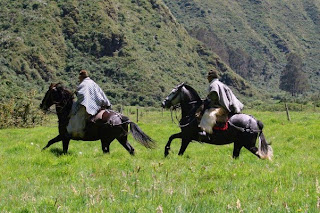So, 110 years later I visit their descendants regularly with my guests on our Horse Safari. After possibly having seen some Pelicans or Flamingos, sometimes a Fish Eagle or a lonely seal cub on the beach, we usually find these horses somewhere in the labyrinth of the wetland systems, split in several groups of four to six, some with a foal, always led by stallions. Considering that they haven’t been touched by man for over 100 years, have no vet to inoculate them against the dreadful African Horse Sickness (towards which they seem to have become inherently immune) and have to survive on the natural grasses of the lagoon and drink the somewhat brackish water, they are looking excellent, as the photo shows .

When visiting, we have to be weary of the stallions, who might, if we come too close, try to kick out at our horses. The mares, however, are quite inquisitive and often come towards us, as the photo of the ridden horse being sniffed at by a wild mare shows.

When we finally canter away, a playful yearling sometimes follows us for several hundred meters.
Carl from the Southern Tip of Africa






